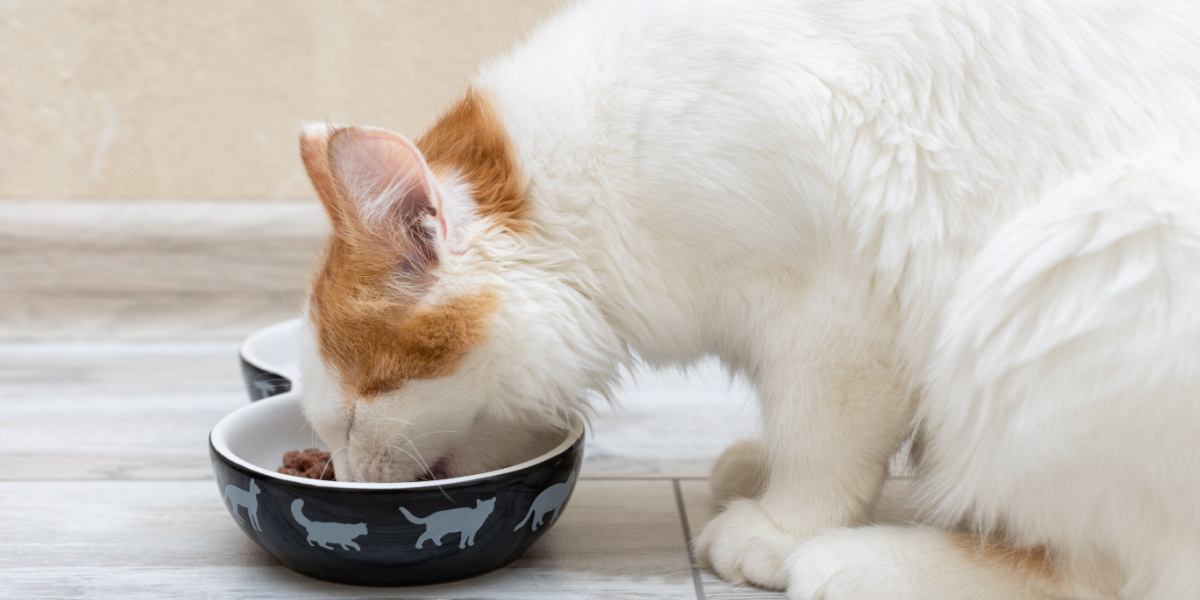
Note: The cat food recipes in this article are not intended to be the basis for a complete diet.
Shopping for cat food can be exhausting and overwhelming. With so many brands and recipes out there, it can be tough to sift through them all. If your cat has allergies, sensitivities, or particular preferences, the task becomes even more difficult.
Cat owners everywhere are making the switch to homemade cat food and it’s certainly an option to consider if you can make it work. We’ve done hours of research and have consulted with veterinarians and pet nutrition experts to learn what homemade cat food is all about.
Before we dive into the details, we want to make one thing clear: homemade cat food isn’t the right choice for every cat or cat parent.
Making your own cat food at home is an option if you want to have total control over what goes into your cat’s diet. It’s also helpful if your cat has severe food allergies or specific nutritional needs that you’re having a hard time accommodating with commercial diets.
All that being said, homemade cat food is a little more complicated than just filling your cat’s bowl with ground meat.
It takes time and research (not to mention a significant financial investment) to create a complete and balanced diet for your cat.
With the help of veterinarian-formulated recipes, it’s definitely possible, but it’s not something you should do on a whim.
Unless you’re a veterinary nutritionist yourself, we don’t recommend creating homemade cat food without a recipe. Nutritional balance is extremely important, and it may be difficult to achieve the necessary amounts of trace nutrients unless you choose your ingredients intentionally.
Try These 6 Homemade Cat Food Recipes
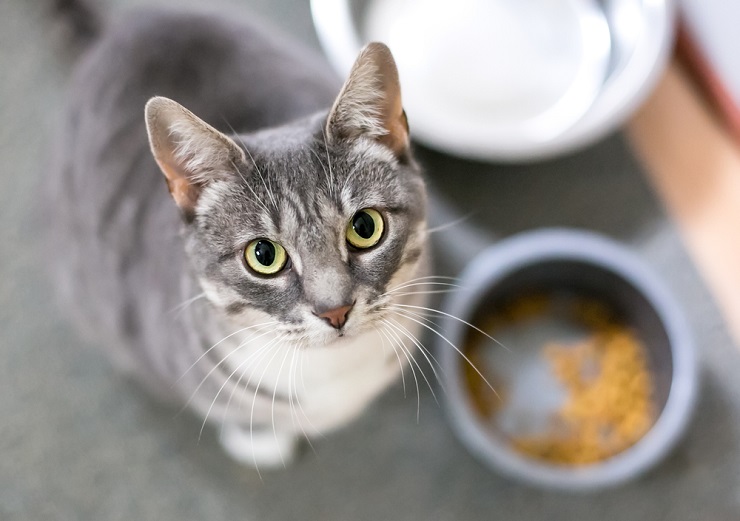
We’ve assembled a small sample of homemade cat food recipes that have been created by veterinarians and veterinary nutritionists in accordance with AAFCO recommendations.
When it comes to homemade cat food recipes, those that you’ll find online are largely similar. Why?
Because they are formulated according to the nutritional needs of cats. Most recipes can be adjusted for different types of proteins, though you’ll need to check the recipe notes to see whether you need to add or subtract things like skin, liver, heart, or other supplements based on your protein choice.
Note: The following three recipes have been gathered from other online resources. We recommend reviewing the recipe with your veterinarian or working with a veterinary nutritionist to make sure it will provide for your cat’s nutritional needs.
1. Chicken Thighs with Bone (from Feline Nutrition Foundation)

This recipe from the Feline Nutrition Foundation is one of the best-trusted options on the web and is a good choice if you want to begin with chicken-based food.
Ingredients:
- 5 pounds chicken thighs with bone
- 7 oz. raw chicken liver
- 14 oz. raw chicken heart
- 8 oz. bottled spring water
- 4 raw egg yolks
- 2,000mg taurine
- 4,000mg wild salmon oil
- 200mg vitamin B complex
- 200 IU vitamin E
- 1 ½ tsp lite iodized salt
- 4 tsp psyllium husk powder (optional)
Instructions:
- Remove the skin from half the chicken thighs, but do not remove the fat.
- Remove the bone from 20% to 25% of the chicken thighs and rinse the meat with water.
- Combine the dry supplements in a small bowl and mix well.
- Whisk in the egg yolks and water to create a slurry.
- Weigh out and chop the chicken liver, heart, and thigh meat.
- Place a bowl under the meat grinder and feed the ingredients through.
- Add the liver, heart, and fish oil capsules at intervals (use the entire fish oil capsule).
- Transfer the ground mixture to a large bowl and mix in the slurry and psyllium husk powder.
- Portion out the mixture and refrigerate or freeze.
Notes: When portioning out the raw food, take into account how much you’ll be feeding your cat at each meal to make it easier on yourself. You can freeze the food in plastic containers, freezer bags, or even ice cube trays to create smaller portions.
2. Cooked Rabbit & Poultry Recipe (from CatInfo.org)

This recipe from CatInfo.org is for cooked food, meaning that you won’t have to worry as much about the pathogens associated with raw meat.
Ingredients:
- 2 to 2.25 pounds whole carcass rabbit
- 75 to 1 pound boneless chicken or turkey thighs
- 1 cup water
- 2 eggs (raw yolk, white slightly cooked)
- 10,000mg fish oil
- 400 IU vitamin E
- 50mg vitamin B complex
- 2,000mg taurine
- 1 tsp lite iodized salt
Instructions:
- Grind the rabbit carcass and chop the poultry into small chunks.
- Bake the chicken or turkey thighs at 350°F for 15 to 20 minutes, leaving 50% of the meat raw.
- Combine the dry supplements in a small bowl and mix well.
- Whisk in the fish oil, egg yolks, water to create a slurry.
- Transfer the ground mixture to a large bowl and mix in the slurry.
- Portion out the mixture and refrigerate or freeze.
3. Raw Cat Food (from Raw Feeding for IBD Cats)
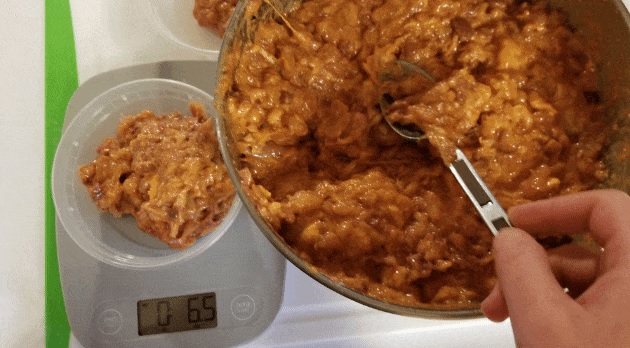
This raw cat food recipe from Raw Feeding for IBD cats is one of the few that’s undergone nutritional analysis.
Ingredients:
- 28 oz. boneless protein
- 2 oz. animal liver
- 6 oz. animal kidney
- 1 teaspoon eggshell powder
- ½ teaspoon vitamin supplement mix (see recipe)
- 500mg salmon oil
- 1 large egg yolk per pound of food
- Water, as needed
Instructions:
- Stir together the eggshell powder and vitamin supplement in a small bowl.
- If using chicken, remove half the skin and include some dark meat.
- Cut the protein, liver, and kidney into chunks that will fit through your meat grinder.
- Place a bowl under the grinder and feed the meat and organs through, adding the salmon oil capsules intermittently.
- Transfer the ground mixture to a large bowl then add the dry supplements, egg yolk, and water as needed to combine.
- Portion out the mixture and freeze or refrigerate.
Notes: This recipe can be fed ground or as chunks. When feeding ground, mix the dry supplements well before adding them to the mix. When feeding as chunks, cut the pieces small – chop it into thin slices rather than square chunks.
4. Raw Chicken and Salmon Recipe (from Health, Home, and Happiness)
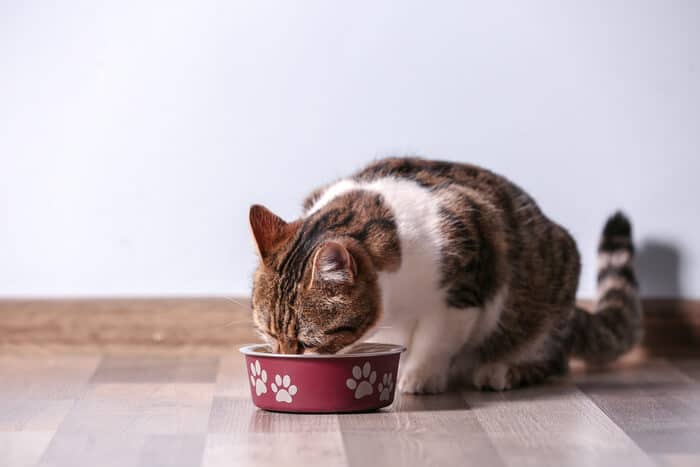
This cat food recipe features raw chicken and salmon as its primary ingredients.
Ingredients:
- 700g raw chicken wings (bone-in, skin-on)
- 100g raw salmon (with bone)
- 100g raw chicken heart
- 50g raw beef kidney
- 50g raw chicken liver
- 1 whole egg, raw (with shell)
- 1 teaspoon taurine supplement
- 2 cups water
Instructions:
- Cut the salmon and organ meats into chunks that will fit through your meat grinder.
- Divide the chicken wings as needed to fit through the grinder.
- Place a bowl under the grinder and feed the meat and organs through.
- Transfer the ground mixture to a large bowl then add the taurine, egg, and water to combine.
- Portion out the mixture and freeze or refrigerate.
Notes: If you don’t have a grinder, you can start by pureeing the organ meats with the egg and water. Cut the chicken wings into pieces and pulse them together with the organ meat puree in a food processor or high-powered blender. If no other option exists, you can chop the ingredients very finely by hand.
5. Single-Serve Cooked Chicken and Rice Recipe (from The Spruce Pets)
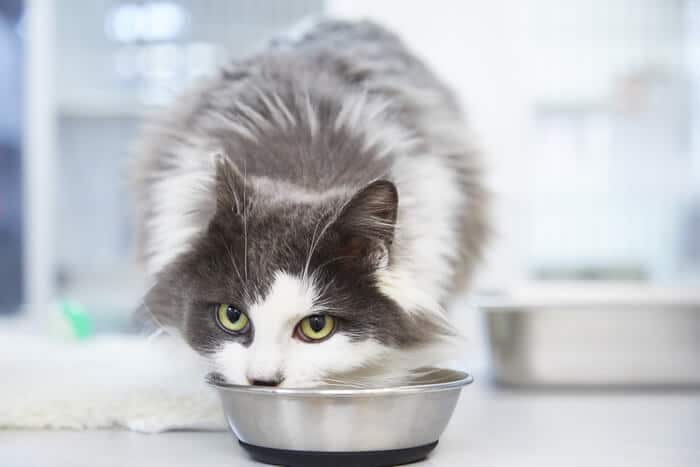
This recipe yields a cooked food featuring a mix of chicken breast, rice, clams, and a few supplements.
Ingredients:
- ¼ cup chicken breast (cooked)
- ½ cup long-grain rice (steamed)
- ½ ounce canned clams, chopped (in juice)
- 1 tablespoon chicken fat
- 1/8 tsp potassium chloride (salt substitute)
- ¼ multi-vitamin tablet, crushed
- 1/10 vitamin B complex tablet, crushed
Instructions:
- Prepare the ingredients separately as desired.
- Chop the chicken and combine with the remaining ingredients.
- Serve immediately and remove the leftovers after 30 minutes.
Notes: This food is not intended to be the basis for a complete diet. The single-serve recipe is easy to scale. Simply multiply the measured ingredients to make larger portions. To store larger portions, combine the chicken, rice, clams, and chicken fat separately from the dry supplements and add them just before serving. Avoid seasoning the chicken and rice when cooking.
6. Raw Pork Recipe Cat Food (created from Raw Feeding for IBD Cats recipe)

This pork-based recipe makes a good alternative to recipes using more common proteins.
Ingredients:
- 28 oz. raw pork, boneless
- 1.6 oz. raw chicken liver
- 1.6 oz. raw beef kidney
- 1 teaspoon finely ground eggshell
- 7 (500 mg) capsules salmon oil
- ½ teaspoon vitamin supplement (see recipe)
- 1 large egg yolk
Instructions:
- Combine the eggshell powder and vitamin supplement in a small bowl.
- Chop the pork, liver, and kidney into pieces that will fit through the meat grinder.
- Place a bowl under the mouth of the grinder and feed the pork and organs through it.
- Add the salmon oil capsules intermittently while grinding the other ingredients.
- Transfer the mixture to a large bowl and add the dry supplements and egg yolk.
- Add water as needed to combine the mixture then portion and freeze or refrigerate.
Also Read: The 8 Best Cat Bowls
Notes: The cut of pork you choose will determine the fat content of the recipe. Pork loin is generally a leaner cut of meat and makes a great starter meat for cats new to raw food. If your cat needs more calories or fat in his diet, you could swap out some of the pork for raw chicken thigh, keeping the skin. If you prefer not to include kidney in your cat’s diet, increase the raw chicken liver to 3.2 oz.
Why Go Homemade?
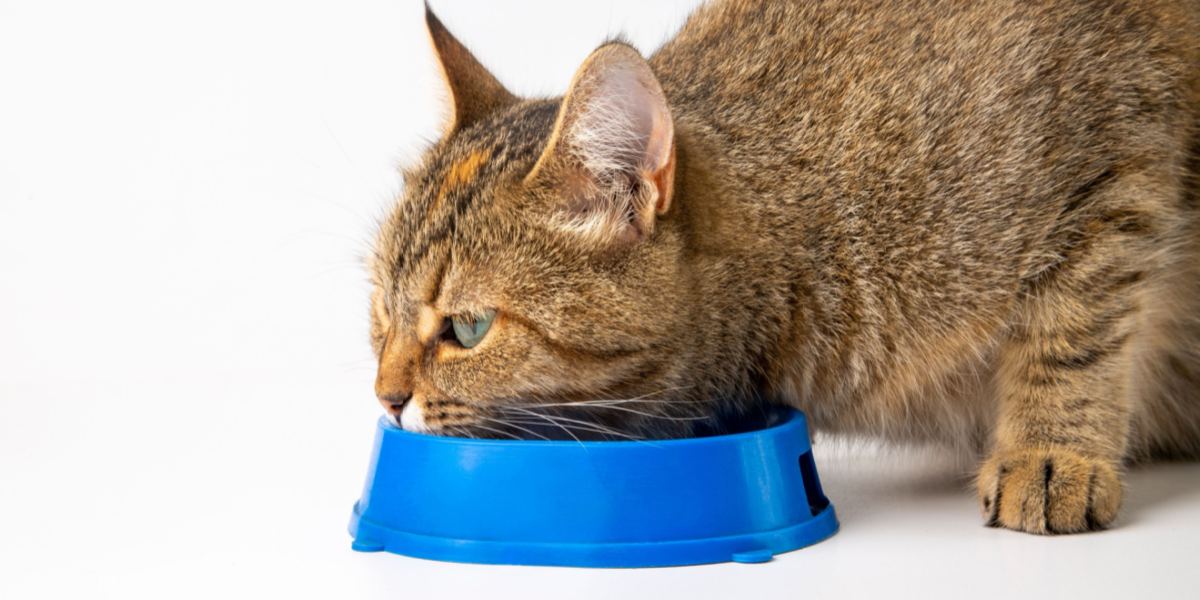
The quality of your cat’s diet is incredibly important. More than just keeping his tummy from rumbling, his food is his primary source of nutrition. Like humans and all other animals, cats require a specific balance of nutrients to keep their bodies functioning optimally.
So, why not just feed your cat premium cat food? What makes homemade cat food a better option?
The truth is all commercial cat foods are not created equal. Pet food manufacturers exist to make money – like any other business – and they use various marketing tactics to do it. Cailin R. Heinze, VMD and writer for the Cummings Veterinary Medical Center at Tufts University, comments on the “premiumization” of pet food.
Premium is a marketing term that was first used in the alcohol industry but has spread to everything from human health and beauty products to pet food. Heinze says, “These products may actually be higher quality than average, or they may just be perceived to be higher quality.”
This is a bigger issue in commercial pet food than many pet owners realize. The FDA regulates certain aspects of pet food manufacture and labeling, but brands have a lot of freedom when it comes to the claims they make on their packaging.
It’s all about encouraging the consumer to choose Brand A over Brand B.
Because the world of commercial pet food is so complex, many cat owners are making the switch, or at least considering making the switch, to homemade. Commercial pet food manufacturers are required to list the ingredients and nutritional analysis for their products on the label, but there’s a lot that goes unsaid. In the end, you can’t be completely sure what you’re buying when you grab a bag of pet food off the shelf.
The Benefits Of Homemade Cat Food
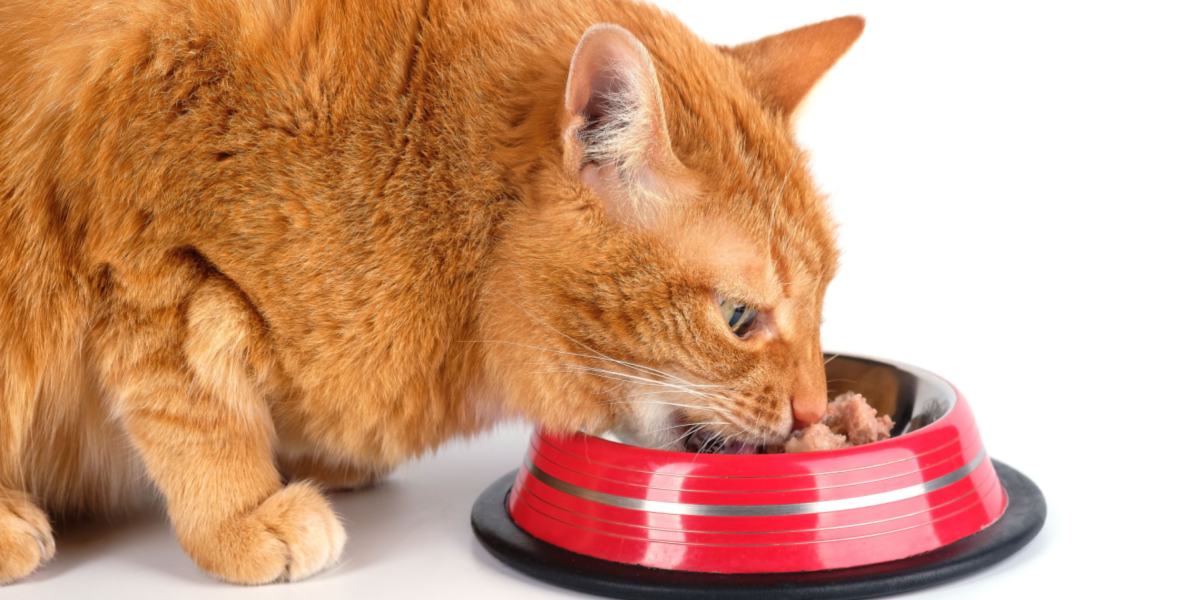
You’ve heard the saying, “If you want something done right, do it yourself.” For many cat owners, that’s the primary motivation behind switching to homemade cat food. If you really want to know what you’re putting into your cat’s body, the best option might be making the food yourself.
Homemade cat food could be a good option for cats who:
- Suffer from food sensitivities or allergies to specific ingredients
- Have specific food and flavor preferences, aka picky eaters
- Have digestive problems, such as inflammatory bowel disease
- Could benefit from a higher level of moisture in their diet
- Experience skin problems related to diet or digestive issues
- Are sensitive to artificial additives and chemical ingredients
The truth is homemade cat food isn’t perfect, but neither is commercial food. As a cat owner, it’s your duty to make a responsible decision regarding your cat’s diet. Whether you choose homemade cat food, a fresh cat food delivery service, or high-quality commercial food is up to you.
We simply want to help you understand the options so you can make an educated decision.
Avoiding Nutritional Deficiencies
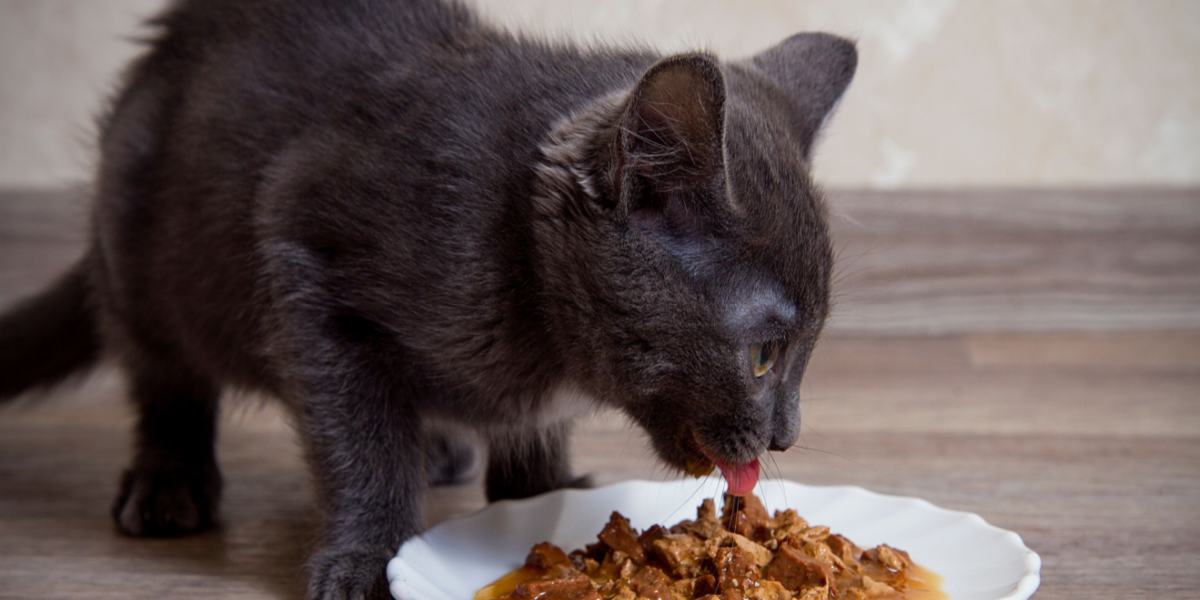
If you were to do a side-by-side comparison of your cat versus a wild cat (for example, a lion), you’d notice the differences immediately. Not only is your cat much smaller, but he doesn’t have the same “wild” look about him. He may think he’s a ferocious beast when he’s chasing down the laser pointer, but the differences between the two are pretty stark.
Except when it comes to their evolutionary dietary needs.
Domestic dogs and cats have changed a lot over time. But, unlike canine dietary requirements, feline dietary requirements have not evolved from their ancient origins. In fact, domestic cats are nearly genetically identical to African wildcats and their bodies are still designed to follow a similar diet.
In other words, cats are carnivores and they always have been.
More than that, however, they are obligate carnivores – they are carnivores by necessity, not just preference. Their bodies are biologically adapted to a diet of raw prey.
Here are some clues that cats are carnivores (specifically, obligate carnivores):
- They have teeth and claws designed to tear flesh
- They have short digestive tracts
- They have digestive enzymes designed to break down protein
- Their bodies are able to utilize animal fat
- Their blood glucose requirements are met through gluconeogenesis (the production of glucose in the body)
- They lack the enzyme needed to turn carotene from plants into vitamin A
What we’re trying to say is your cat’s body requires a very specific type of diet: a meat-based diet.
The only way to keep your cat healthy and avoid nutritional deficiencies is to feed him the type of diet his body can process and utilize properly.
Commercial diets are formulated to provide for your cat’s minimum needs in terms of essential nutrients, but they aren’t all biologically appropriate. If you’re going to feed your cat homemade food, it needs to be nutritionally balanced and optimized for your cat’s biology so his body can digest it and utilize the nutrients properly.
Key Nutrients For Feline Diets
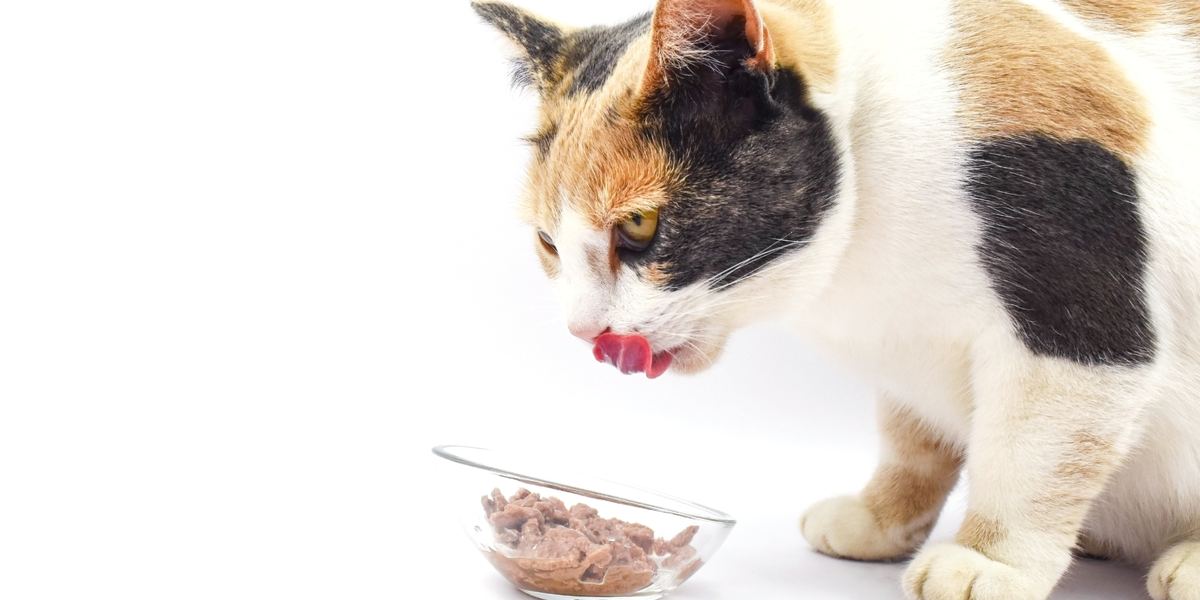
Before setting out to make homemade cat food, you need to understand the basics of your cat’s nutritional needs. After all, what good will it do to switch your cat to a homemade diet if it doesn’t actually benefit him more than his previous diet?
All cats are unique, but their core nutritional needs have a common foundation.
Cats require the following five nutrients in their diet:
- Protein
- Fat
- Vitamins
- Minerals
- Water
Protein is the most important nutrient for obligate carnivores like cats and it needs to come from animal sources. This may include poultry like chicken or turkey, meat like beef or lamb, or even fish. Decisions about which protein to use in your homemade cat food will come down to your cat’s preferences (and any allergies or sensitivities), as well as availability and pricing.
Like protein, fat should come from animal sources. When using poultry, you can use a mixture of white meat and dark meat to ensure appropriate fat levels. If you’re using lean poultry like rabbit, you may need to add animal fats to your recipe.
Vitamins and minerals are essential for cats but are needed only in small amounts.
Though your cat may need less of these micronutrients than he needs of fat and protein, he has specific requirements to prevent nutritional deficiencies.
Animal proteins provide some key vitamins and minerals, but you may also need to include organ meats or a nutrient pre-mix to ensure nutritional balance.
Water is also incredibly important for cats, especially considering cats don’t tend to drink a lot on their own. Adequate hydration is needed to keep all of a cat’s body processes working properly. Fortunately, fresh food is generally much higher in moisture than commercial dry food.
Notice Anything Missing From This List? That’s Right – Carbohydrates.
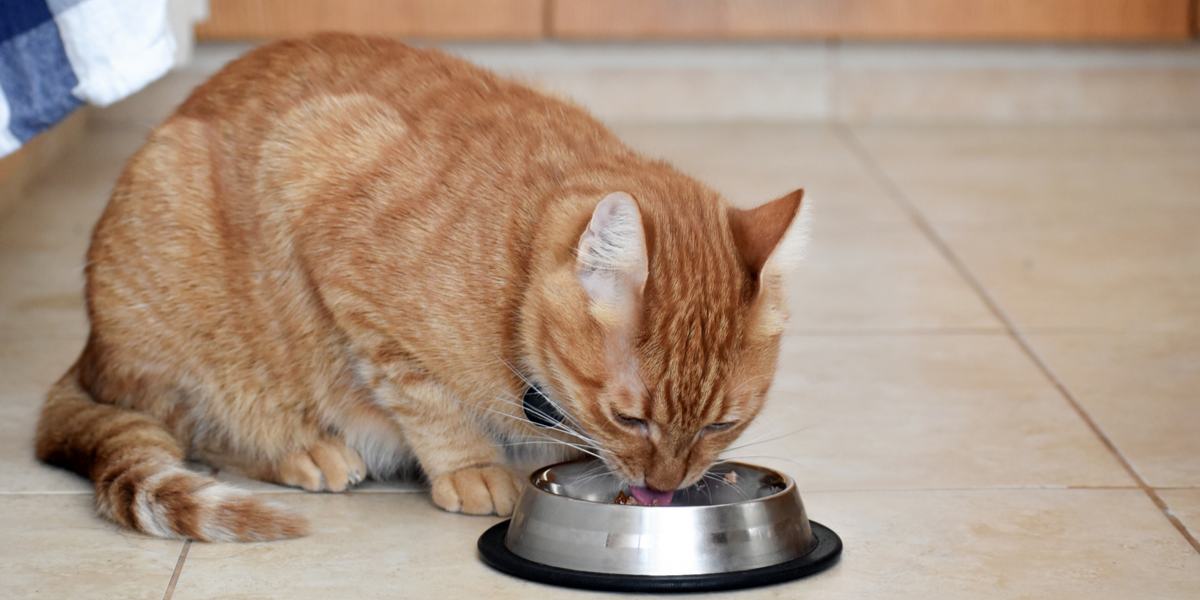
As obligate carnivores, cats have no biological requirement for carbohydrates in their diet. In fact, their bodies aren’t designed to digest plant materials and don’t have the enzymes necessary to derive certain nutrients from them. That being said, cats can use glucose from plants for energy. Also, complex carbohydrates, known as fiber, can help with digestion.
Overall, though, carbohydrates have no biologically necessary role in a homemade cat food diet.
What About Fresh Cat Food Delivery?

By now you’re probably asking yourself whether homemade cat food is worth the effort. If you’re willing to put in the time to do it properly, we really think it is. That being said, it’s definitely a time-consuming commitment and it may not be a practical choice for everyone.
If you love the idea of homemade cat food but you’re not ready to take the leap, consider a fresh cat food delivery service as a steppingstone.
In an age where you can have just about anything delivered right to your door, pet food is no different. Companies like The Farmer’s Dog and Spot & Tango ship a month’s worth of fresh dog food (frozen) to your home and fresh cat food companies are gaining speed as well.
Smalls offers gently cooked in human-grade USDA certified facilities. Their recipes are designed in accordance with the nutritional levels established by AAFCO Food Nutrient Profiles and they send you individual bags of food pre-portioned according to your cat’s calorie needs. Simply open the thawed pouch and pour it right into your cat’s bowl.
As a quick side note, ‘AAFCO’ stands for the Association of American Feed Control Officials. One of AAFCO’s roles is to “regulate the sale and distribution of animal feeds and animal drug remedies,” as stated on the AAFCO website. AAFCO also ensures that a pet food meets minimum nutritional requirements.
If you really want to feed your cat’s carnivorous side, we’d recommend Darwin’s Natural Pet Products. This fresh, raw pet food delivery company offers fresh frozen meals made from 100% real meat with raw bone, formulated specifically for obligate carnivores.
Fresh cat food delivery is a convenient option. But it’s just as important to do your research with food delivery services as it is with commercial cat food. Make sure the company uses veterinarian-formulated recipes and high-quality ingredients. As always, protein is key!
The Pros And Cons Of Homemade Diets
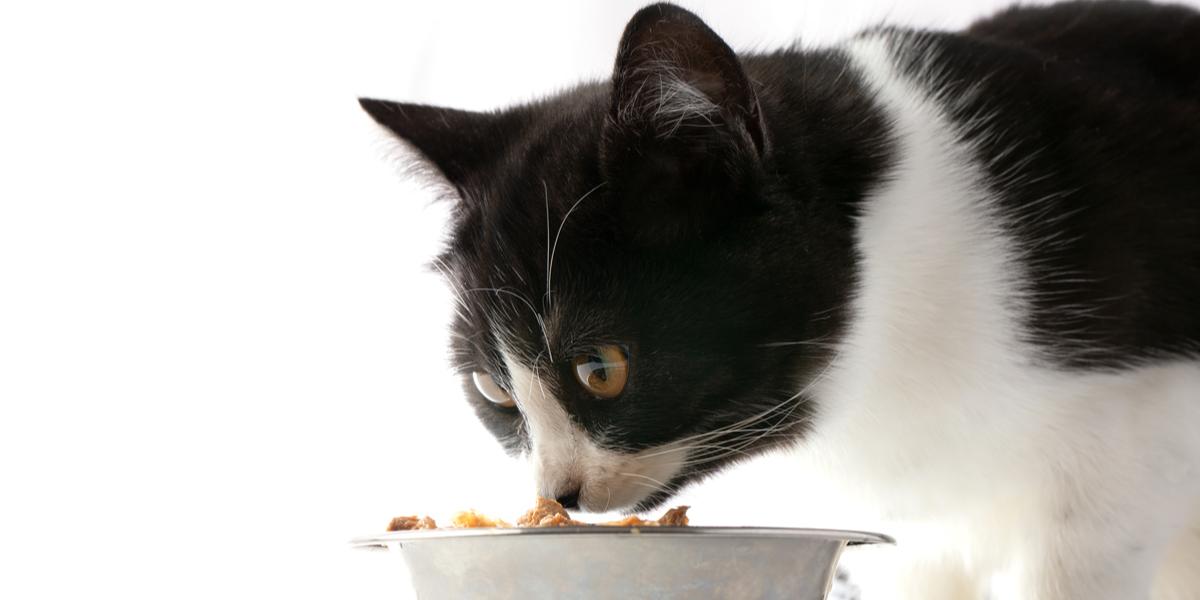
Choosing a diet for your cat can be difficult at the best of times, but it can be even more of a challenge when you are considering making it yourself.
The benefits of homemade cat food are significant, but your cat will only receive those benefits if you choose a properly balanced recipe and prepare it correctly. Homemade cat food isn’t a simple switch, but it may well be worth the effort.
Before you make your final decision, consider the pros and cons of homemade cat food.
Pros Of Homemade Cat Food:
- You have complete control of the ingredients that go into your cat’s diet.
- It may provide higher-quality nutrition than a commercial diet.
- You can customize it to accommodate food allergies and sensitivities, as well as other health problems.
- It may improve your cat’s digestion (read: smaller, firmer stools and less litter box odor).
- You can choose the primary protein and flavor according to your cat’s preferences.
- It may be easier for senior cats and cats with dental problems to chew.
- You can mix supplements directly into the food for easy administration.
Cons Of Homemade Cat Food:
- Preparing a homemade diet takes more time than pouring a bowl of kibble.
- It can be more expensive to feed your cat homemade food.
- Achieving balanced nutrition can be tricky – only use a veterinarian-formulated recipe.
- It can be a little more difficult to store the food to avoid foodborne illness.
- Once your cat transitions to a homemade diet it may be reluctant to switch back.
Switching your cat to a homemade diet isn’t a decision that should be made lightly.
If it isn’t properly balanced, a homemade diet can actually be worse than a commercial diet.
It’s very important to talk to your veterinarian before making the switch and make sure you choose a homemade cat food recipe formulated by an animal nutritionist or veterinarian.
It is crucial that you consider your cat’s overall health when deciding whether to feed your cat a homemade diet. For example, cats with chronic kidney disease need a special diet that must have a precise balance of nutrients to reduce the workload on the kidneys. T
his balance may be difficult to achieve with a homemade diet. Again, your veterinarian will help you decide the most appropriate diet for your cat.
Additional Tips And Tricks
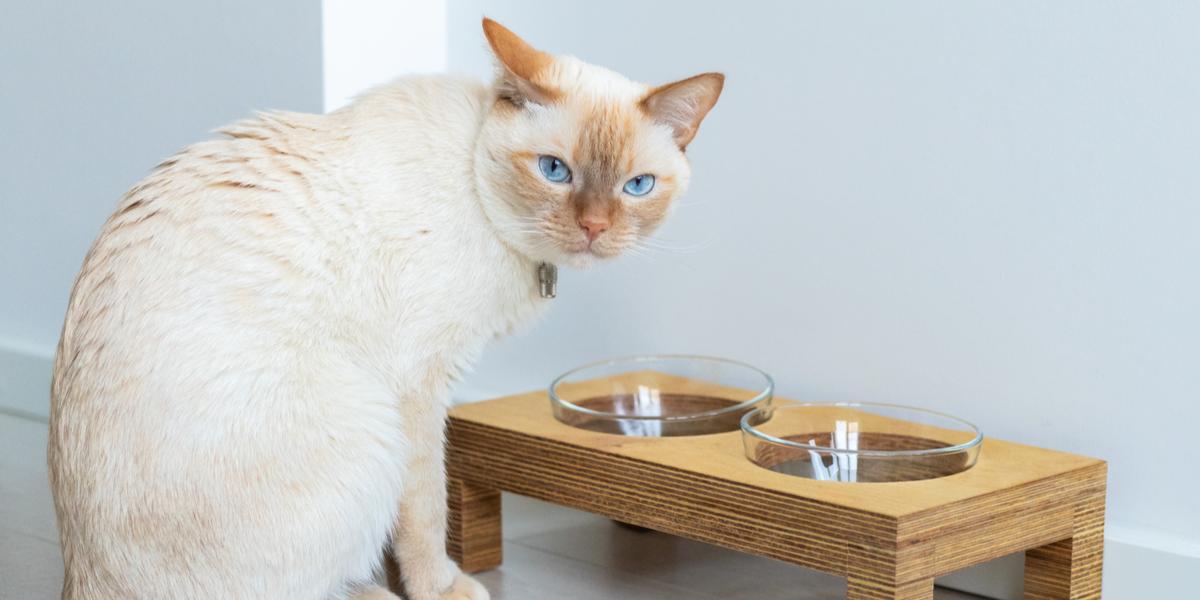
Before you make the switch to homemade cat food, we recommend doing as much research as you can. We’ve done our best to give you an overview, but there’s a lot more to learn if you’re going to do it yourself. Talk to your own veterinarian and check out online resources to learn directly from cat owners who have tackled the challenge of homemade cat food themselves.
If You’re Going To Make The Switch To Homemade Cat Food, Do It Slowly!
Sudden changes to your cat’s diet can trigger digestive upset, so it’s important to transition your cat over a period of at least 7 to 10 days. If you’re switching from commercial food to raw food, you may want to extend the transition a little longer just to be safe.
The Most Important Thing You Can Do For Your Cat Is Keep Up With Routine Veterinary Exams.
Every cat should see the vet for an annual checkup, but it’s even more important when feeding your cat a homemade diet. Your veterinarian can help you keep tabs on your cat’s wellness to make sure he’s staying healthy on a homemade diet.
Frequently Asked Questions
Is homemade cat food safe?
Commercial cat food is processed in specific ways to destroy foodborne pathogens. If you’re switching to homemade cat food, you’ll need to take certain precautions to keep you and your cat safe. For example, take these precautions when working with raw meat:
• Clean and disinfect all surfaces and cooking tools (food bowls, spoons, etc.) that came into contact with the raw meat
• Wash your hands thoroughly after preparing a meal with raw meat
• Do not allow your cat to lick your face after he’s finished his meal
• If you have children, ensure that they do not touch the raw meat or allow the cat to lick their faces after the cat finishes his meal
When properly prepared and stored, homemade cat food is perfectly safe.
How much does homemade cat food cost?
The cost of homemade cat food varies significantly depending on the ingredients you choose and the amount you feed your cat. Pricing will also vary depending whether you chose a cooked or raw homemade diet.
Is raw cat food better than cooked?
Raw cat food is generally regarded as the most biologically appropriate diet for cats by animal nutritionists, but it isn’t the right choice for every cat owner. Also, raw meats can contain bacteria, such as E. coli, that cause foodborne diseases. Do some research to compare the different options and decide which works best for your cat.
How much should I feed my cat?
The average adult cat needs about 200 calories per day, or about 6 ounces of homemade food. The calorie content of the food will vary, of course, depending on the proteins and fats you use. Talk to your veterinarian and consult online calorie calculators to determine your cat’s specific calorie requirements and go from there.
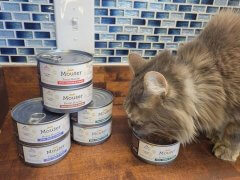


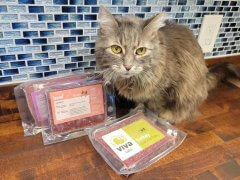
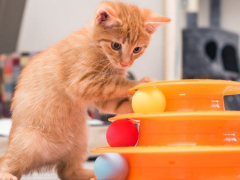



“vitamin supplement (see recipe)”
What recipe?
Hi PS! There’s a link to the full recipe with details on the supplement mix above the recipe printed here. I’ve copied and pasted the supplement details for you here:
“Please note the supplement is made separately from the batch. Only a portion of the supplement is used when making two pounds of food as per recipe instructions.
50 capsules of NOW 1,000mg taurine20 tablets of NOW standardized kelp (150mcg)10 capsules of Blue Bonnet or Twinlabs chelated manganese (10mg)5 capsules of NOW dry vitamin E (400iu)2 capsules Natural Factors Hi-Potency B-complex*****Vitamin D*****Vitamin D: If you are using 500mg of salmon, anchovy, or sardine oil daily, you do not need to include D. If you are using krill oil or green lipped mussel as the source of omega 3s, it is best to include vitamin D in the supplement: 20 NOW 1,000iu dry vitamin D capsules. Increase the amount of supplement used to a slightly rounded 1/64 teaspoon per ounce. Yes, organs are a healthy source of vitamin D in the diet. And yes, it is true that cats are not known to have a “high” requirement of vitamin D. But in humans, the importance of vitamin D
and the understanding of its many functions is changing, and it is clear a “vitamin D deficiency” cannot necessarily be measured directly. Importantly, in cats, low levels of vitamin D are associated with IBD and intestinal lymphoma. Further, a study conducted in the UK found that cats admitted to the ER for ANY reason were more likely to return home alive if they had higher levels of circulating vitamin D. This is why we think ensuring vitamin D is VERY important, and one sardine a week is not enough. Add all capsules and tablets (you can include the gel caps) to a clean coffee grinder. Grind (pulsing) until well-mixed and finely ground. Let settle for 10 – 15 minutes or you will have a dust cloud when you open the grinder. Store in a glass jar.”
Read the full recipe here.
Are you sure the vit D is safe? My cat with IBD had severely low vit d levels. My vet instructed me to add 1 drop to her food per day but cautioned me to be sure that my other cat didn’t touch that food. She said that even small amounts of vit D for a cat without low vit D could kill the cat.
Hi Shannon, unfortunately, I can’t say that the vitamin D values will definitely be perfect for your cat; there are many factors that can come into play and change your cat’s overall nutrient intake. As long as this is your cat’s sole diet and you’re following the recipe precisely, the amount of vitamin D should be good, but it’s impossible to guarantee that without proper testing.
Don’t people that come here want to make their cat food, at least in part, to save on cost? This recipe sounds like it will cost a fortune.
I’ve been under the impression that Raw Salmon is contraindicated for cats due to parasites. At least this is what I’ve read about Pacific Coast Salmon. Dont know about Atlantic Salmon ,which to my knowledge, is farmed and not wild caught.
Hi there! You’re right—there is an issue with raw Pacific salmon containing Anisakis worms, and from what I can tell, this presents an issue for cats as well. Some suggest freezing the fish to kill the parasite, but they’ve been shown to survive freezing in some cases, so it does seem that this is a bit risky, but that risk applies to humans who eat raw fish in sushi and other dishes as well. I’ll add a note cautioning readers about this. Thank you!
You’re not the only one concerned about this! Once I bought some fresh Pacific Salmon from C***Co and immediately went home to prepare it. Moments after it hit the grill, hundreds of tiny white worms started squirming out of it, to escape from the searing heat below! Needless to say, I couldn’t eat it myself! However, knowing worms are sometimes used as food in certain countries, and if COOKED PROPERLY, they are also a protein. I had never heard of this one or if they had any potential for toxic effects after being cooked! I fed all the salmon to my barn Cat’s, who thoroughly enjoyed it and suffered no harm!
There’s always room for learning!! Thanks for this information!
Thank you for this comment. I actually thought that feeding any kind of raw fish isn’t recommended.
I really need to know what to fix for a 2 and a half year old Maine Coon mix male who has already had surgery for urinary crystals that I can also feed my other cats along with a recipe for treats. I have 5 cats ranging from 9 years down to the Maine Coon, both male and female all are fixed.
Hi Sabra! Since your cat has a history of problems with urinary crystals, it may be best to ask your vet for specific advice. That being said, our research suggests that increasing the moisture content of your cat’s diet could be incredibly beneficial to help dilute some of the minerals that contribute to crystal formation. Any of the recipes above will provide a good source of moisture, though we’d also recommend adding some water or broth to each meal. For fresh treats, you could try small pieces of cooked chicken or fish or even sardines packed in water (no salt added), Hope you find something your cats love!
Hi, just noticed some discrepancies between the original “Raw feeding for IBD” recipes and the ones you supplied in the article.
They use 3.2 ounces of liver.
They use 1.6 ounces of kidney, not 6, and if used they reduce the liver to 1.6 ounces.
They use 7 – 500 mg capsules of salmon oil, thus 3500 mg total.
Your article was very helpful in providing resources and demystifying the whole process.
Thank you!
Hi Nadia, thanks for bringing that to our attention! We’ll look into it. Thanks!
Thanks Nadia, I’ve updated the post with the corrections!
Hello, do you have an ingredient substitute suggestion for fish oil? My cat is allergic to fish.
Hi Jessica, thanks for the question. While there is a chance that your cat will have a reaction to the oil, I wouldn’t entirely rule out this ingredient. The fish proteins are what cause the allergic reaction, and, while there may be traces of protein in the oil, fish oil is not an inherently protein-inclusive product. At least according to this Verywell article, there was one limited study that found that six out of six fish-allergic people were able to take fish oil supplements without having an allergic reaction. To make sure that it’s as safe as possible, you might want to look into a molecularly distilled fish oil, which undergoes a process that’s supposed to get rid of all contaminants, including proteins that could trigger a reaction. Here are some capsules from Now Supplements that might work. Otherwise, you may have to find some kind of vegan omega-3 supplements and add them instead of oil, but unfortunately, I don’t know exactly how much EPA, DHA, and other fatty acids are needed to make these recipes nutritionally complete. If you’re able to contact one, a talk with an experienced veterinary nutritionist may help.
Hello, if I dont have the grinder for the bone, can I use eggshells powder instead? If yes how much should I add to a batch of recipe 1?
Hey Linh, you can use eggshell powder instead! The Feline Nutrition Foundation recommends 3 grams of powder per pound of meat. In terms of volume, this will vary depending on which type of eggshell powder you’re using, so weighing it out works best.
Hello,
I appreciated the “adult supervision” prior to operating the heavy machinery, [meat grinder]. You walk-through of the process was helpful, and motivating. Watching my little beastie dive in to her food is such a pleasure! She came out covered nose to neck when I made poutine gravy thickened with carrageenan kappa and CMC [carboxyl methyl cellulose]. The latter is a starch made from cotton or other plant fiber, purified and processed into a rheology modifier aka thickener, like in shampoo or any number of sauces otherwise watery are transformed with this stuff, the 2 fibers I chose are quite typical, one is plant cellulose and the other is found in seaweed and offers numerous health benefits. It is a standard food additive found in sauces, ice creams, dough, yoghurt, etc. The recipe is from scratch and very easy, so I wanted to share it with the cat loving community and especially their cats. Buy some chicken feet and necks, or turkey. If you are familiar with Poutine [Not the Russian warmonger, the French Canadian junk food, although the confusion is hilarious] chicken necks are the magic ingredient that gives the gravy such rich flavor it invites checking the label for MSG! I copied the great wisdom [to be fully candid, they were stupidly cheap at an Asian supermarket I frequent, I think about $2 for nearly a kilo! They had deals on chicken hearts and feet also. The feet are a great stock ingredient, and if you have 6 hours to kill, I suppose they can be a tasty snack, but festooned with a miasma of bones smaller than legopeople heads. Great for stock. I use a pressure cooker and do not brown anything, I add 1 carrot and 1 celery stalk but no onions. 15 to 20 minutes at 15PSI is plenty of time. Meanwhile, heat some water to boiling, about 200 to 300ml, you can get all sciency about it and do it in a beaker to claim the high holy ground of expertise and bask in the glory. Add 5 to 10 grams of carrageenan kappa powder and dissolve by stirring with the heat off. Prepare a similar batch with the CMC, also 5 to 10 grams. I have a preference for the carrageenan but you can use HPMC, MCC, CMC, MC, pullulan, konjac, carrageenan, casein, agar agar, gelatin, tapioca or potato starch, guar gum, xanthan gum, gum acacia, or even the classic roux (melted butter and wheat flour). There are even idiotproof gravy thickening powders sold at your supermarket, potato starch comes to mind. I have worked with all of the above both in my cooking experiments and my job as formulator. They are all similar in how they work, if you ever made jello or bechamel, you are an expert, off you go! These watery meat flavored gravies, broths, and consommés will make your cats go absolutely bananas. Be ready for purring to shame a Harley V-twin or competition chainsaw, senseless walking in circles and in effort to express “HF WOW Thanks!! Do that again soon!” they will leave a Rorsach face print in chicken gravy on you pants and sofa. Mine nearly did an Elvis and aspirated some of it amid frenzied eating, sparking off several paroxysms of sneezy hyperventilating. The entire spectacle is precious. I laughed until tears came. I helped the sneezing kitten with a timely baby wipe, feeling like a pit crew mechanic at Nascar — the moment she could breathe, no stopping her, she dove back in. I wondered what would happen if I took it away! LOL! I wrote this to offer an amusing way to make sure they get plenty of water in their diet. This gravy could not be any easier, Total prep time is 2 minutes, you toss in the meat with 2 cups water and optional vegetables, set timer for 17 min, dissolve 2 powders in hot water, strain through colander when time is up, you can power-vent the pressure cooker, or come back for it later, once strained, stir in half of the water solutions you prepared and cool in a bowl in the sink with water underneath it, this allows dialing in the amount of viscosity to your ideal target. Rheology modifiers mostly work while temperature cools, so you can notice what happens, have feedback, and develop0 a feeling for it. Some of these additives offer serious health benefits, I invite some Wiki perusing.
Thank you so much for the entertaining and detailed recipe complete with adorable reviews, Mark. Have a good one!
I forgot to ask my question, it has to do with the fashionable crushed egg shells, which if soil calcium remediation is your goal, it does the job, but if replenishing calcium electrolytes or combatting osteoporosis, then chalk is not the ideal choice. The absorption by the body is less than dazzling. Calcium carbonate is chalk, and eating chalk will make you poop grout mortar, you bones still as weak as before. The supplement industry correctly features calcium picolinate and citrate as more bioavailable calcium salts, and they even toss in some magnesium and calciferol. These are not hollow sales gimmicks, this is a well studied biochemical process [such a thing is perfectly suited for scientific inquiry, there is one nutrient in question, so the complexity of a creature can be ignored for the most part, and calcium can be measured ad nauseum, and it’s been done. This is all well documented. Questions like is wheatgrass juice a health benefitting thing to consume, and is it worth it to suffer its horrific taste for these benefits. For that, scientists are mute, better ask the hippies. But I digress… Do cats have similar biochemical pathways for calcium absorption to humans? And if yes, could you then please jump to the forefront and discourage the feeding of eggshells to them, as it is pointless and can’t taste any good either! If on the other hand I am the one that needs disabusing, please then, disabuse me!
Mark, this is an excellent question, and I’d like to get to the bottom of it as well, though I’m not sure that I have the background to do so in a timely fashion. Passing this along to our veterinary team to see if one of them has an answer. Thank you!
Hi Mark and thank you Mallory for calling me on to help with this.
The area of calcium absorption and metabolism has not been nearly as well researched in cats compared to humans, so there are many questions that are difficult to answer with authority. While what you say may well be true Mark, I cannot locate any evidence to support your contentions, and meanwhile, calcium carbonate (egg shell) has been used for decades as a supplement for cat food, and it seems to be effective. The amount of calcium and its bioavailability does vary significantly between different sources of calcium and determining which is best can be difficult (Calcium carbonate, Calcium citrate, Calcium sulfate, or calcium chloride). The most important fact to remember is that bone meal (a commonly used supplement in some recipes) contains calcium and phosphorus, so egg shell (calcium carbonate) is definitely better than this, as it does not contain phosphate, and the ratio of calcium:phosphate in the diet has very significant implications. The information given here is general and non-specific: if you want individualised, detailed nutritional advice, you should consider consulting with a dedicated professional service such as Balance IT (www.balancit.com) or consult with a board certified veterinary nutritionist. I hope this helps a bit.
You failed to mention the many precautions that should be taken when handling and processing raw meat, organs, and ground bones. The CDC recommends against feeding a raw diet to cats and dogs. The American Veterinary Medical Association opposes the unregulated feeding of raw foods to pets. No vet would simply recommend a raw food recipe withhout cautioning you on the dangers, and numerous precautions that need to be taken for the safety of you and your cat. The dangers are even greater when feeding older cats, or or cats with compromised immune systems.
From the CDC website:
CDC recommends against feeding raw food to dogs and cats because of the risk of illness to the pet as well as to people living in the household. Do not feed your pet a raw diet. Here is why:
• Raw diets consist of foods such as meat, poultry, milk, and eggs that have not been cooked or treated to remove harmful germs.
• These food items can carry harmful bacteria including Salmonella and Campylobacter.
From the AAHA:
The American Animal Hospital Association (AAHA) approved a policy in August 2012 that discourages feeding raw meat to pets. The National Association of State Public Health Veterinarians (NASPHV) and American Association of Feline Practitioners (AAFP) both endorsed the AAHA statement. The policy was developed independently of the AVMA’s position, but was shared with AVMA prior to posting on the website.
From the AVMA:
The AVMA discourages the feeding to cats and dogs of any animal-source protein that has not first been subjected to a process to eliminate pathogens because of the risk of illness to cats and dogs as well as humans.
This is helpful information, James. Thanks!
I’m glad someone as yourself brought this to their attention. I would cook every bit of these recipes. As it simply states that it is bad to give cats raw egg. It’s bested to be boiled or fully cooked. Same for all meat
Very one-sided and outdated information. Of course you have to be careful with raw meats. You fail to mention that animals are way less susceptible than humans to the risks involved in eating raw. Big Pet has a big hand in promulgating the anti-raw movement for obvious reasons.
https://www.dogsnaturallymagazine.com/why-feed-raw/
https://littlebigcat.com/avma-vs-raw-food/
https://catinfo.org/making-cat-food/#Raw
Great Information! Thank you
My container of Whole Foods Organic Psyllium Husk powder has a warning label regarding high lead levels. I tossed it.
I thought cats couldn’t process salt. Is it safe to add salt to their diet?
Cats can process salt, and many cat foods contain added salt as a source of sodium. I would consider it safe as long as the amounts are not excessive.
what would you consider excessive? so many commercial brands of “wet” cat foods do not indicate percentage levels of salt as do human consumption canned foods, so how is it measured to determine what is accepable and what is excessive? Please reply to my email [email protected]
The AAFCO has established a minimum amount of sodium that cats require to stay healthy, and manufacturers will often add salt to meet that requirement. But for food made in the United States, there is no official upper safe limit. In fact, an article by Dr. Jennifer Coates on PetMD mentions a 2015 study that found no adverse effect after cats ate diets with abnormally high levels of sodium for 2 years! Still, the National Research Council (another organization that establishes standards for pet food) puts the safe upper limit of sodium in feline diets at 740 mg/mJ (megajoule) of metabolizable energy (ME), or 1.25 g/kg in 4000 kcal ME/kg diets).
Thank you for these recipes! They seem ideal. My cats refuse to eat Smalls, and every other high-quality food I give them has some snag or another — inappropriate “gum” binders**, for example.
I want to try these recipes, but am of course concerned about contamination and other risks with raw food.
What if I were to steam or slow-cook the mash of raw ingredients and then add the taurine and vitamins etc?
Could there be a way to cook the raw parts and retain as much nutrition as possible?
**Also, how about using gelatin as a binding agent?
Hi Naima, yes, you can make cooked cat food that is nutritionally complete and balanced—you just need to use a recipe developed for cooked ingredients. This vet-written page has some information on doing so.
Thank you for the recipes. We currently have a colony of 8 cats plus one very feral girl. They had been on a diet of Wellness Brand cat food and devour a 12.5 oz can per day. They are fed high-quality kibble in the evening. The cost for canned cat food was $32/week not counting supplemental canned fish. I made cat food in the past and I have just renewed the practice. I have a meat grinder and pressure processor. Taurine comes from “Bulk Supplements,” B complex, fish oil, etc. comes from whoever has the best price. And of course, I invested in canning jars. I need to find organ meats. Maybe a butcher shop. There has been zero problem in switching the kitties to my homemade food.. They love it. I add some vegetative matter — like green peas or string beans – for fiber. I don’t really want to use psylum husk. I make up enough food for at least two weeks at a time. For immediate use I refrigerate; for longer term storage, I can it at 15 lb pressure. I won’t use raw meat. The chicken is roasted from COSTCO. Including supplements, I estimate I am spending a little over $7 per week for wet cat food and giving them better nutrition than store-bought. By the way, I grind the egg shells and add to the mix as a calcium. source. I also boil down the bones that are too large to grind and use that as a source of chicken broth. I suspect our cats eat better than a lot of people do.
Hello!
I don’t know if this has been mentioned before but the numbers are wrong in your recipe # 3 from this site: https://www.rawfeedingforibdcats.org. The right amount of liver is 3.2 ounces (not 2) and the right amount of kidney is 1.6 ounces (not 6). if you DO use kidneys, you are to reduce the amount of liver to 1.6 ounces). Here is where you can find the original recipe: https://www.rawfeedingforibdcats.org/balanced-raw-food-recipe-with-nutritional-analysis.html
Yikes, thank you so much for letting us know! Correcting the article now. 🙏
Can cats and doig have supplements made for humans?
Yes! Most of these cat food supplements are straightforward enough that they don’t contain any additives that would be harmful to cats.
Can bone meal be used as a substitute for the ground bone? I don’t feel comfortable with grinding bones. What if I make a mistake? If so what would be the portion for the bone meal? Thank you.
Hey there. You can substitute bone meal for the ground bone in these recipes. Another option is a product called MCHA, which is microcrystalline hydroxyapatite calcium. In contrast to bone meal, which is cooked, this is a freeze-dried bone powder and retains more of the nutritional qualities of fresh ground bone. Remember that, in addition to the variations in nutritional value from cut of meat to cut of meat, different bone meal brands will have different levels of vitamins and minerals. However, the standard recommendation is between 1/2 and 1 teaspoon of bone meal for every pound of meat in the recipe. Given all of the complexities here, I’m afraid I can’t give a confident substitution ratio, and I would recommend consulting with a veterinary nutritionist before altering a cat food recipe.
Great recipes except for one thing. Why all the salmon oil and other fish oils in the rabbit, chicken, pork etc recipes? My cat is highly allergic to fish, and every can of sold cat food has fish and fish oil in it. I found out the hard way. I brought my kitty a can of cat food, she took two mouthfuls of it and was violently ill. Not all cats are the same, we need more though t to be put into recipes for the kitties.
Sorry to hear about your cat’s struggles, Nikk! Fish oil is a strong source of omega-3 fatty acids and, unfortunately, one of the easiest options for homemade cat food recipes. You may want to ask your vet first, but there is an algae-based omega-3 oil that could be a possible substitute in your cat’s case. You can find it on Chewy here
Rice is a carb, isn’t it? Rice isn’t a good food for cats. I know that some cheaper pet foods may use it, but cats can only have a little once in a while. And tho it’s not toxic, if I’m going to the trouble to prepare my own cat food, why would *I* want to add rice?
Hi Betsy! You’re right, carbohydrates like rice shouldn’t be the foundation of a diet for cats. As noted in the article, this particular recipe is designed to be used occasionally and not as the basis for a complete diet.
I am a beginner and I do feed Ash 2 kinds of Orijin dry(mixed) which has minerals and viamins added. Do I need to add the vitamins and minerals to the raw? Due to mouth work before adopting, he is so picky and only likes a smooth pate. I am off of any commercial wet food. (due to the sodium selenite &j Medadione Sodium Bissulfite). I am not sure he will eat raw he likes Safe Catch salmon(no salt) added to his dry (pureed in the juice). I did check out Darwin’s Natural Pet Products but that is not an option at present. More supplemental minerals and vitamins yetn needed? suggestions
Good question, Laurel! Any food that makes up a significant portion of your cat’s staple diet needs to be complete and balanced. If you’re not using a nutritionally complete raw food, consider looking into a nutrient premix like TC Feline (there are other brands too). You just mix it with raw meat and water to create a balanced homemade diet. Here’s some info about TC Feline: https://cats.com/tcfeline-cat-food-review
What kind of meat grinder do you suggest that can handle the bones too?
Good question, Laurel. I’m in the process of researching this myself! From comments I’ve read on homemade pet food forums, it seems the best grinders that can handle bones are going to be the more expensive ones. People seem to like Weston and Tasin brands, specifically Weston #8 and Tasin 108 for bones. People recommend cutting the bones into small pieces as much as possible before grinding.